![]()
![]()
![]()
Use LEFT and RIGHT arrow keys to navigate between flashcards;
Use UP and DOWN arrow keys to flip the card;
H to show hint;
A reads text to speech;
9 Cards in this Set
- Front
- Back
- 3rd side (hint)
|
North geographic pole |
Directions referred to the north geographic or 'true' pole are called true directions and use 't' to identify them e.g, 030t, hdg (t) , tr (t) |
|
|
|
North magnetic pole |
Directions referred to the north magnetic pole are called magnetic directions and use 'm' to identify them, eg, 270m, hdg (m) . Tracks are generally not measured relative to magnetic north |
|
|
|
Compass north |
Directions referenced to the direction of north on a particular magnetic compass are called compass directions and use 'c' to identify them, e.g, 005'c' , hdg 'c' . Tracks are not measured relative to compass north |
|
|
|
Aircraft longitudinal axis |
Directions referenced to the longitudinal axis of an aircraft are called relative directions or relative bearings and use 'r' to identify them, eg, 300r, brg(r) |
|
|
|
True directions |
The four cardinal directions named by the early astronomers ie north south east and west are true directions, ie, they are directions related to the true or geographic pole. As shown in figure 1 point 1.7, these directions are important since directions measured from charts are true directions, ie, they are related to true north. On a chart, meridians of longitude all indicate true north and or south. Parallels of latitude indicate true east and or west directions |
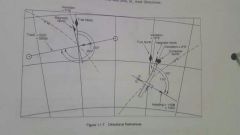
|
|
|
Magnetic Directions |
Magnetic directions are related to the magnetic north pole. The earth has magnetic properties often known as terrestrial magnetism and, because of these properties, it acts like a huge magnet. The magnetic poles are located close to the geographic poles. Unlike geographic poles the magnetic poles are not in a fixed position. They move very slowly in a circular direction around the geographic poles. A freely suspended magnet influenced only by the earth's magnetic field will indicate the direction of these magnetic poles. The angular difference between true north and the direction indicated by a freely suspended magnet influenced only by the earth's magnetic field is known as variation. Thus variation is the angular difference between true north and magnetic north. Variation (var) is called east (e) or west (w) depending on whether the magnet points to the east or west of true north, ie, weather magnetic north is east or west of true north. Variation at different places can be determined by magnetic survey. From the survey, places on a map with equal magnetic variation are joined by lines called Isagonals. These isagonals are printed on most navigational charts so that pilots can determine the value of the magnetic variation for the places along the track they wish to follow |
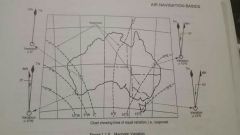
|
|
|
Magnetic directions |
The value of variation at a particular place changes with time because the position of the magnetic poles is continually changing even though only slowly. This is one of the reasons it is important to use current charts for navigation. Charts are regularly re-printed with the most up-to-date isogonals. Magnetic direction is important to navigation because there is no light weight, inexpensive instrument that senses true direction directly. Sophisticated modern navigational systems sense true direction in a variety of ways but the study of these systems is well beyond the scope of this book and the systems are not normally installed in recreational aircraft. |
|
|
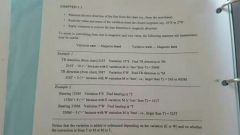
Magnetic directions
Conversion of directions from true to magnetic and vice versatile |
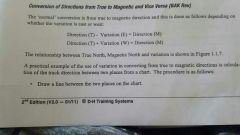
The normal conversion is from true to magnetic direction and this is done as follows depending on whether the variation is east or west
Direction (t)- Variation (E) = Direction(M) Direction (T)+ Variation (W) = Direction (M) |

Variation east magnetic least variation west magnetic best |
|
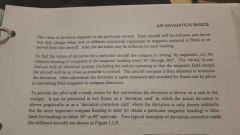
|
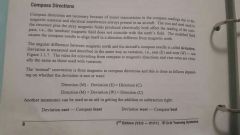
|
|

